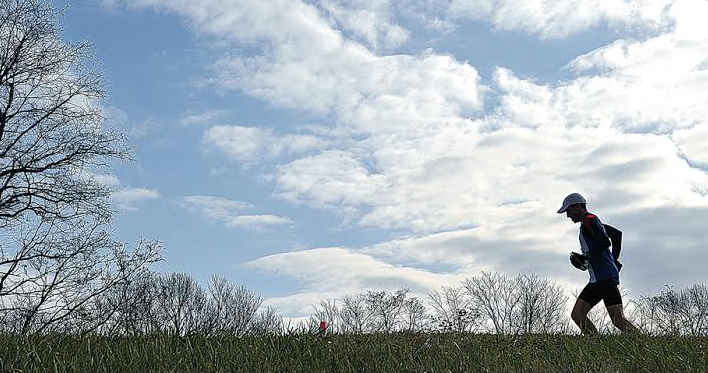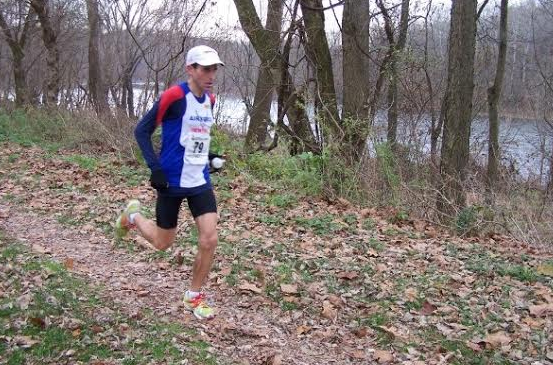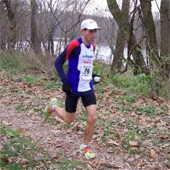 In preparation for my return to the JFK 50-mile run this weekend, I’d like to share my race report from the 2008 run. This top photo was taken at mile 48 and made the front page of the Hagerstown Herald Mail in Maryland. It captures the spirit of ultra running. I wanted to relive this experience again. Large road marathons are excitement; trail ultras are about the peace.
In preparation for my return to the JFK 50-mile run this weekend, I’d like to share my race report from the 2008 run. This top photo was taken at mile 48 and made the front page of the Hagerstown Herald Mail in Maryland. It captures the spirit of ultra running. I wanted to relive this experience again. Large road marathons are excitement; trail ultras are about the peace.
***
From November 24 2008. Most citizens of Shepherdstown, West Virginia, awoke Saturday morning November 22, saw the wind and the mercury at 20 degrees, wisely stayed in bed or brewed some more coffee, unaware that in their backyard the oldest and largest ultramarathon was taking place–the JFK 50 mile run.
An ultramarathon is any distance greater than a marathon, this one coming in at 50.2 miles. Over 1000 runners enter the race, which is large for ultras. This race is so popular all the spots were filled in early August. The first JFK 50 Mile Challenge was held in the spring of 1963 spurred on by President Kennedy’s call for improved fitness for all Americans. Bobby Kennedy reportedly did a non-stop 50 mile hike in 17 hours (U.S. News & World Report, February 25, 1963). After the assassination in November 1963 the race name changed to the JFK 50 Mile Memorial.
This was the 46th edition of the race. The Washington County, Maryland course rises up South Mountain from Boonsboro, crosses the Appalachian Trail (AT) for 14 miles until a rocky descent to Weverton, cruises up the Chesapeake and Ohio (C&O) Canal towpath for 26 miles, and then finishes with 8 miles of rolling rural roads to finish in Williamsport. Most states in the country and several foreign countries are represented in the field. This was my third attempt at the race. The first one in 2006 was unsuccessful as my body shut down at Taylors Landing (mile 38). I had never run more than a marathon distance (26 miles) but the call of the local event was too strong. I learned some running (and life) lessons from the experience; in second place at half way, in a car at 38 miles.
No runner is content after not finishing a race and the JFK was no different. My last DNF was the 1989 Boston Marathon, but I’ve returned successfully 15 times since. At the 2007 JFK 50 a conservative plan led to a 16th place finish in 6:57. Content in having finished the race, the plan was to return again this year and attack it a bit more. On race morning most runners awake in hotels, I had the luxury of sleeping in my own bed, making my favorite coffee, and giving the family a quiet goodbye while they slept in. I would be 4 hours till returning to Shepherdstown at mile 30.
 The bank thermometer in Boonsboro read 19 degrees, and the wind report was 20 miles per hour from the upstream direction of the Potomac. That was of little concern now, the first challenge is surviving the rocky Appalachian Trail. I rendezvoused with fellow runners Andy Mason of Hagerstown (last years 9th-place finisher) and 2006 winner Pete Breckenridge. They were stripping down to shorts. Though they were more experienced at the ultra distances, they followed the “trust me I’m a doctor” advice and put some long running pants on. The three of us started the climb to the South Mountain Inn together, and then separated on the AT. Andy ran the most cautious on the trail, Pete went ahead. Fifty miles later we would end up finishing within 10 minutes of each other in 9th, 10th, and 11th. Running the Appalachian Trail is what separates this event from other faster road or trail races.
The bank thermometer in Boonsboro read 19 degrees, and the wind report was 20 miles per hour from the upstream direction of the Potomac. That was of little concern now, the first challenge is surviving the rocky Appalachian Trail. I rendezvoused with fellow runners Andy Mason of Hagerstown (last years 9th-place finisher) and 2006 winner Pete Breckenridge. They were stripping down to shorts. Though they were more experienced at the ultra distances, they followed the “trust me I’m a doctor” advice and put some long running pants on. The three of us started the climb to the South Mountain Inn together, and then separated on the AT. Andy ran the most cautious on the trail, Pete went ahead. Fifty miles later we would end up finishing within 10 minutes of each other in 9th, 10th, and 11th. Running the Appalachian Trail is what separates this event from other faster road or trail races.
If one considers the C & O portion trail, this stretch is rock and ice. The goal is to get through it without damage. Even with gentle short steps and careful foot placement, I took two decent falls, but rolled back to my feet and kept going. The last descent into Weverton is the most treacherous as you dodge the rocks down the switchbacks. No letting up on the focus as a fall here could end the day. At Weverton I was thankful that no train was blocking the cross over to the canal and that my stash of Powergels was where I left it the day before.
Physiologically a body can absorb 240 calories an hour while running. That is 2 gels an hour, and I prefer the chocolate and double caffeinated latte Powergel varieties. A 50-mile race is no time to try new things. Having consumed the 4 gels I carried from the start, this new fuel would get me to my family waiting 15 miles upriver in Shepherdstown. I did not understand this principle in the 2006 and took 4 gels an hour, and returned most of that back to the trail 22 miles into the race, along with a stomach of Gatorade. The right turn onto the C&O necessitated a change in strategy. The wind was hard and cold into the face. World Class Runner Johan Oosthuizen from South Africa was the first off the trail. His goal was to break the course record, that goal would be impossible today. He held on for a 4th place finish after the aggressive start. I was about 25th off the trail, but confident that I could run down many of the fast trail runners. My strength is road marathons, and the event was now a running race.
The stretch between Harpers Ferry and Shepherdstown (WV) went as well as could be expected. I averaged 7 minutes a mile into the wind and enjoyed the support of the crowds gathered in Antietam Creek Campground and along the Canal. This was a bit quicker than prudence would dictate, but I had 8 family members waiting for me in Shepherdstown and was anxious to greet them. After giving my wife, kids, nieces, and nephews a few high fives and hugs, it was now time for the lonely and challenging stretch of the race. The soft surface of the C & O, although welcoming at first, becomes fatiguing. There are 11 more miles of canal between Shepherdstown until you leave at Dam 4. Taylors Landing at mile 38 is the real turning point of the race. Those who continue on from here finish.
My wife Roberta and kids greeted me here with “energy hugs,” restocked my double caffeinated gel supply, and headed to the pizza parlor in Williamsport. It would be over an hour and a half before I arrived. Besides the fueling strategies another trick to get through the later stages of an event like this is finding the right “hybrid” effort. Using fat as fuel is efficient and essential, this is electric mode. If one goes too fast- the fuel is gas, easier to access but way less efficient. Like a Prius, the transition is subtle….a little too quick and you are operating on gas and before you realize it you are running dry. Another trick is developing efficient stride movement.
I usee a technique which focuses onlanding midfoot, avoiding the braking of heel strike and using the core muscles as power generators. It works for long distances as one cannot push off with the small muscles of the feet and calves for nearly 7 hours. Dam 4 is a welcome site, now a change of surface and the 8 mile countdown on Dam 4 Road to the finish. Thestrategy here is to run from mile marker to mile marker. The first one you see is “8 to go.” The mental ploy after jogging past is “only 7 miles and change to go.” At marker “7 to go”…only “6 and change”…and so on, one at a time. A JFK vet shared this wisdom now used by many. Rounding the final turn to the finish at the Williamsport Middle School brings a final spring in the step. You wipe the snot off, smile, hug and high five the waiting family, and cross the line.
Mike Spinnler the race director announced me in as the first Masters (age 40 plus) and first military finisher (this race has a long history of service runners) with a finish time of 6 hours 45 minutes, and 11th place overall. After the rough rookie performance, Mike kept the faith and invited me back. The next finisher from West Virginia was another local, 44-year-old James Munnis, in a solid 141st place in 8:54. This was James’ first attempt at the distance, so even more remarkable. Hot showers were waiting in the school along with warm soup and pizza. The hot water heater at the school is legendary as runners cross the line well into the evening, all greeted with ample hot water. The volunteers are also legendary and in a race where brief rest is good, the runners stop and thank them.
As a rule runners do not litter the trail either–no city-marathon drink and throw cup. Our accomplishments are nothing compared to a few of the participants who have finished over 25 of these, and are now bringing their kids to run with them. They are fulfilling what JFK envisioned in 1961 at the Conference of Physical Fitness and Heath: “We do not want in the United States a nation of spectators. We want a nation of participants in the vigorous life. This is not a matter which can be settled, of course, from Washington. It is really a matter which starts with each individual family…”
Many thanks to my sponsors Newton Running and Powerbar for the footwear and fuel to get to the finish.

